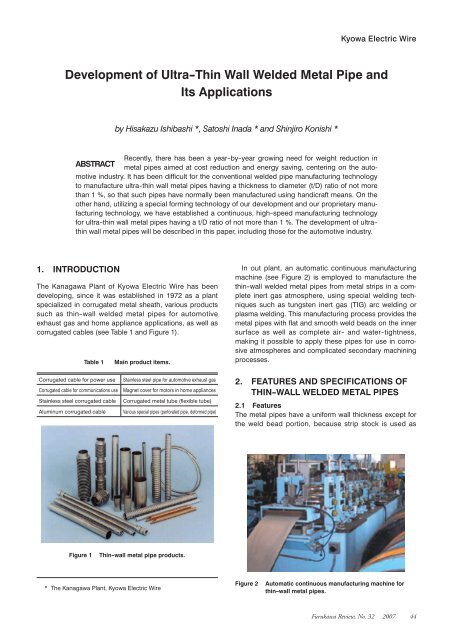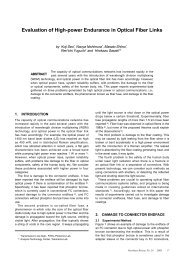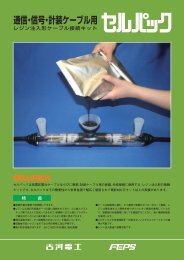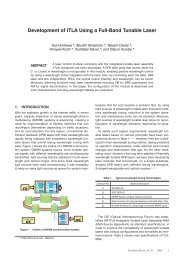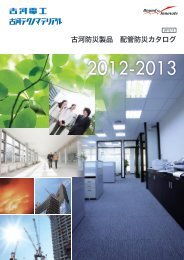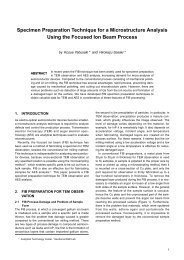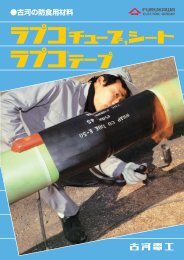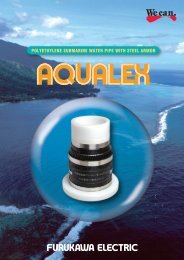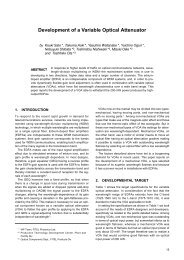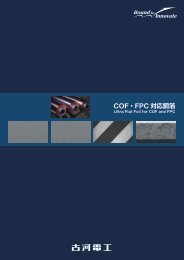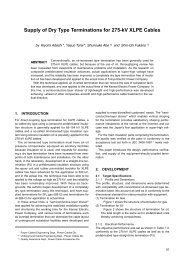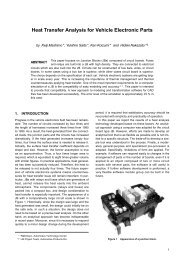Development Of Ultra-Thin Wall Welded Metal Pipe
Development Of Ultra-Thin Wall Welded Metal Pipe
Development Of Ultra-Thin Wall Welded Metal Pipe
You also want an ePaper? Increase the reach of your titles
YUMPU automatically turns print PDFs into web optimized ePapers that Google loves.
<strong>Development</strong> of <strong>Ultra</strong>-<strong>Thin</strong> <strong>Wall</strong> <strong>Welded</strong> <strong>Metal</strong> <strong>Pipe</strong> and<br />
Its Applications<br />
by Hisakazu Ishibashi *, Satoshi Inada * and Shinjiro Konishi *<br />
Recently, there has been a year-by-year growing need for weight reduction in<br />
ABSTRACT metal pipes aimed at cost reduction and energy saving, centering on the automotive<br />
industry. It has been difficult for the conventional welded pipe manufacturing technology<br />
to manufacture ultra-thin wall metal pipes having a thickness to diameter (t/D) ratio of not more<br />
than 1 %, so that such pipes have normally been manufactured using handicraft means. On the<br />
other hand, utilizing a special forming technology of our development and our proprietary manufacturing<br />
technology, we have established a continuous, high-speed manufacturing technology<br />
for ultra-thin wall metal pipes having a t/D ratio of not more than 1 %. The development of ultrathin<br />
wall metal pipes will be described in this paper, including those for the automotive industry.<br />
1. INTRODUCTION<br />
The Kanagawa Plant of Kyowa Electric Wire has been<br />
developing, since it was established in 1972 as a plant<br />
specialized in corrugated metal sheath, various products<br />
such as thin-wall welded metal pipes for automotive<br />
exhaust gas and home appliance applications, as well as<br />
corrugated cables (see Table 1 and Figure 1).<br />
Table 1 Main product items.<br />
Corrugated cable for power use Stainless steel pipe for automotive exhaust gas<br />
Corrugated cable for communications use Magnet cover for motors in home appliances<br />
Stainless steel corrugated cable Corrugated metal tube (flexible tube)<br />
Aluminum corrugated cable Various special pipes (perforated pipe, deformed pipe)<br />
Figure 1 <strong>Thin</strong>-wall metal pipe products.<br />
* The Kanagawa Plant, Kyowa Electric Wire<br />
Kyowa Electric Wire<br />
In out plant, an automatic continuous manufacturing<br />
machine (see Figure 2) is employed to manufacture the<br />
thin-wall welded metal pipes from metal strips in a complete<br />
inert gas atmosphere, using special welding techniques<br />
such as tungsten inert gas (TIG) arc welding or<br />
plasma welding. This manufacturing process provides the<br />
metal pipes with flat and smooth weld beads on the inner<br />
surface as well as complete air- and water-tightness,<br />
making it possible to apply these pipes for use in corrosive<br />
atmospheres and complicated secondary machining<br />
processes.<br />
2. FEATURES AND SPECIFICATIONS OF<br />
THIN-WALL WELDED METAL PIPES<br />
2.1 Features<br />
The metal pipes have a uniform wall thickness except for<br />
the weld bead portion, because strip stock is used as<br />
Figure 2 Automatic continuous manufacturing machine for<br />
thin-wall metal pipes.<br />
Furukawa Review, No. 32 2007 44
the time of evaporation and condensation. When one end<br />
(high-temperature end) of a heatpipe containing a working<br />
fluid is heated, the working fluid vaporizes absorbing<br />
heat. The vaporized working fluid diffuses in the pipe to<br />
reach the other end (low-temperature end) to condense<br />
emitting latent heat there. In this way, heat is efficiently<br />
transferred from the high-temperature end to the lowtemperature<br />
end.<br />
At present heatpipes are extensively used in such applications<br />
as snow melting system using geothermal heat,<br />
temperature control in spacecraft, heat dissipation in electrical<br />
equipment, and home appliances. Because our corrugated<br />
pipes of stainless steel and copper possess, taking<br />
advantage of the manufacturing process in a completely<br />
inert gas environment in addition to continuous<br />
long-length welding, perfect air- and water-tightness as<br />
well as flexibility that make the pipes suitable for long distance<br />
piping, it is expected that the pipes find wide applications<br />
in the next-generation heatpipe systems.<br />
7. CONCLUSION<br />
In response to the weight reduction requirements including<br />
those from the automotive industry, we have developed<br />
the manufacturing technology for ultra-thin wall<br />
<strong>Development</strong> of <strong>Ultra</strong>-<strong>Thin</strong> <strong>Wall</strong> <strong>Welded</strong> <strong>Metal</strong> <strong>Pipe</strong> and Its Applications<br />
welded metal pipes that can endure, in spite of their<br />
reduced thickness, in severe secondary processes and<br />
application environments. By combining it with corrugation<br />
technology, the pipe manufacturing technology<br />
allows for making proposals for, and manufacturing of,<br />
next-generation commodities that can cope with environmental<br />
issues and energy conservation.<br />
REFERENCES<br />
1) Kazukiyo Kobayashi: Introduction to Welding Technology, 2nd edition,<br />
Rikogakusha Publisher (1999), 263. (in Japanese)<br />
2) Kenzo Kato; Journal of the Japan Society for Technology of<br />
Plasticity, 22 (1981), 1129. (in Japanese)<br />
3) Kenzo Kato; Journal of the Japan Society for Technology of<br />
Plasticity, 20 (1979), 859. (in Japanese)<br />
4) Kenzo Kato; Journal of the Japan Society for Technology of<br />
Plasticity, 23 (1982-8), 731. (in Japanese)<br />
5) Minoru Hasegawa: Mechanical Materials (4th edition), Rikogakusha<br />
Publisher (1993). (in Japanese)<br />
6) Yoshiro Siba: Journal of the Geothermal Research Society of Japan,<br />
27 (2005). (in Japanese)<br />
7) Geo-Heat Promotion Association of Japan: Brochure of Geo-Heat<br />
Promotion Association of Japan. (in Japanese)<br />
Furukawa Review, No. 32 2007 48


